Saint-Étienne hosted Lille at Stade Geoffroy-Guichard in the late kick-off in Ligue 1 this past Sunday.
Despite these two teams sitting quite far apart from one another on the table, with Lille hoping to mount a title challenge for 2019/20 Ligue 1 winners and UEFA Champions League finalists PSG this season and Saint-Étienne hoping to keep themselves out of a relegation battle for a second year running, this match was quite closely contested and it ended in a 1-1 draw.
In this tactical analysis piece, we’ll provide some analysis of the tactics that both Saint-Étienne and Lille utilised in all phases of Sunday’s game. We’ll look at why Saint-Étienne dominated the first 45 minutes and how Lille managed to turn things around in the second half and examine why a draw may have been the fair result here when all was said and done.
Lineups and formations
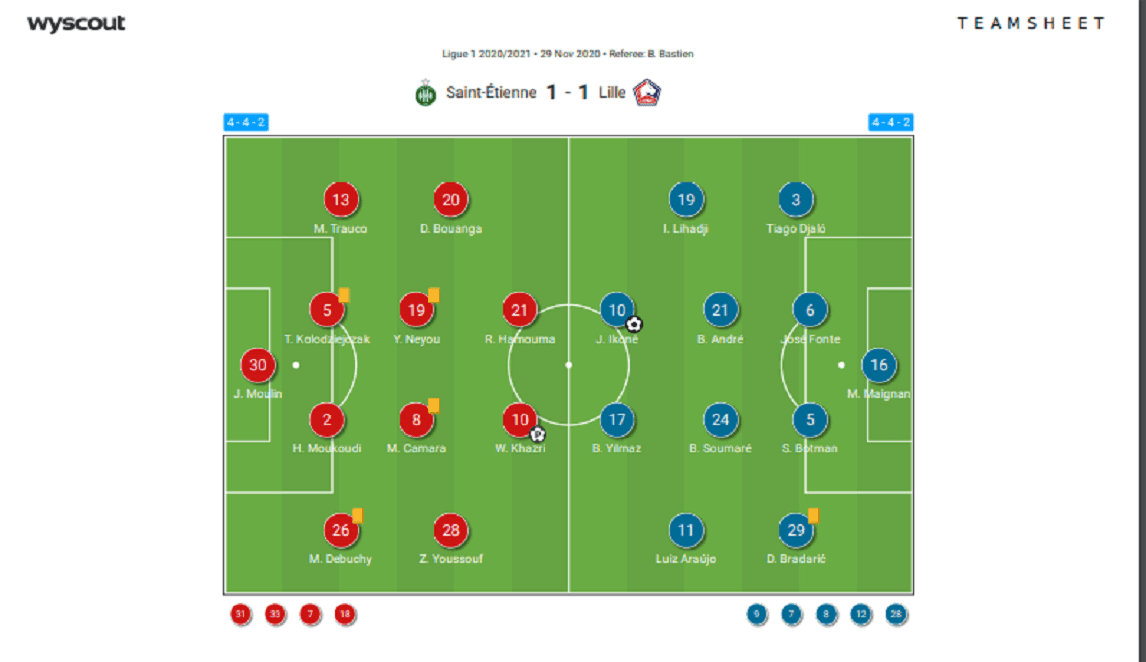
Firstly, we’ll look at how the home side lined up for this fixture. Claude Puel set his team up in a 4-4-2 shape for this game. This is the shape that Les Verts have used more often than any other during the 2020/21 campaign thus far, so perhaps there were no major surprises there.
Jessy Moulin started in goal for the home side, while the back four in front of him consisted of veteran right-back Mathieu Debuchy, left-back Miguel Trauco, right centre-back Harold Moukoudi and left centre-back Timothée Kolodziejczak.
Saint-Étienne’s central midfielders were Mahdi Camara and Yvan Neyou, while Denis Bouanga started at left-wing and Zaydou Youssouf started at right-wing.
Lastly, the strike partnership of Wahbi Khazri and Romain Hamouma led the line for Puel’s side.
Arnaud Nordin replaced Khazri in the 66th minute of the game, Ryad Boudebouz took Hamouma’s place at the 74th minute, Alpha Sissoko replaced Debuchy in the first minute of second-half stoppage time, while Lucas Gourna-Douath was Saint-Étienne’s last substitute, as he also came on in the first minute of second-half stoppage time, replacing Youssouf.
As for the away side, Puel also lined his Lille team up in their regular 4-4-2 shape to start this game, though their shape changed into a 4-2-3-1 in the second half, as we will discuss at greater length later in this tactical analysis. Mike Maignan started in goal for Les Dogues, while Tiago Djaló started at right-back, Domagoj Bradarić started at left-back, José Fonte played at right centre-back and Sven Botman played at left centre-back.
Boubakary Soumaré and Benjamin André started in central midfield for Christophe Galtier’s men, while Luiz Araújo started at left-wing and Isaac Lihadji started at right-wing. Meanwhile, Galtier went with a strike partnership of Jonathan Ikoné and Burak Yılmaz.
Lille made their first changes of the game in the 68th minute when Yusuf Yazıcı replaced Ikoné, Jonathan Bamba replaced Lihadji and Reinildo Mandavia took the place of Bradarić. Central midfielder Xeka later replaced André in the 86th minute, at the same time as, lastly, Jonathan David came on for Araújo.
Saint-Étienne’s tactics off the ball
Now, we’ll provide some tactical analysis of Saint-Étienne’s tactics without the ball from Sunday’s Ligue 1 fixture. Firstly, Puel’s side generally pressed quite aggressively from the front for the majority of this game and deployed quite a high defensive line.
This was particularly effective at limiting the amount of space Lille had to play inside of Saint-Étienne’s half and preventing them from building out from the back via short passes.
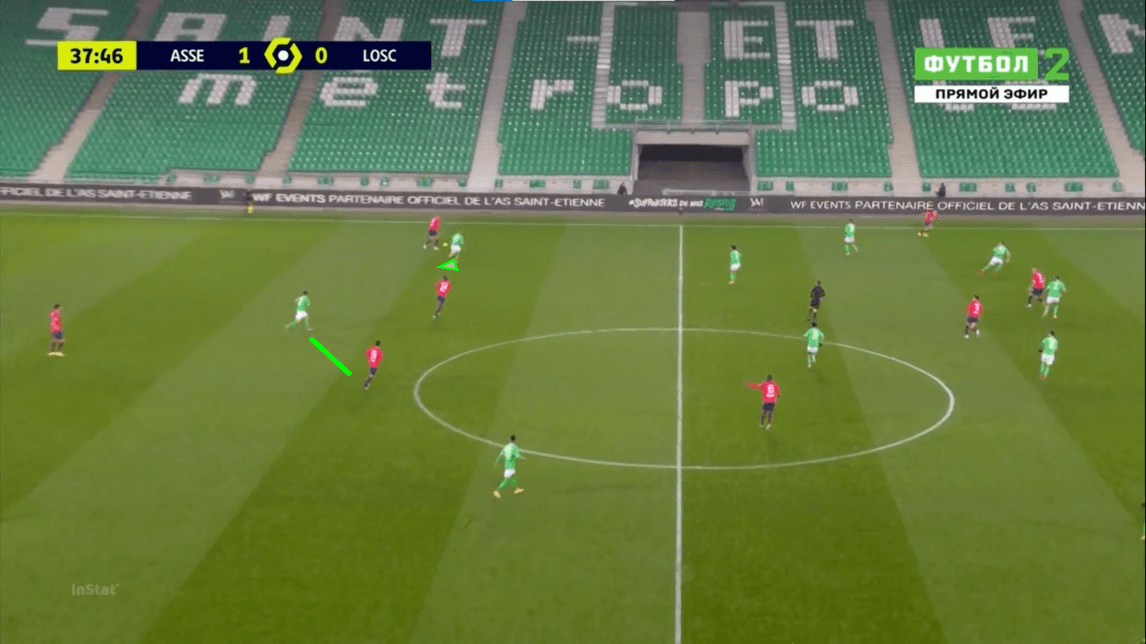
The image above provides us with our first example of Saint-Étienne’s defensive shape and the main aspect of their defensive tactics that we’re focusing on here is the positioning of their front two, and how it was influential in preventing Lille from being able to build from the centre-backs into the centre of midfield. They successfully prevented the short passes during the build-up from Lille’s centre-backs to the central midfielders throughout this game.
During the build-up, as we will discuss later, Lille utilised a back three and here, we can see left centre-back Botman in possession of the ball. During the build-up of attacks, Lille switched the ball across the backline through Fonte and over to both of the wide centre-backs in an attempt to try and open up gaps in Saint-Étienne’s defensive shape and create better progressive passing angles into midfield.
However, here we can see how Les Verts’ front two of Hamouma and Khazri effectively guarded against Lille doing this. One of the strikers always stayed relatively close to the nearest of Lille’s two central midfielders and they altered their positions to block the passing lane from the centre-back on the ball into that midfielder. The two attackers’ intelligent positioning and pace to quickly get into the correct position and block the relevant passing lane in time as Lille played the ball between the centre-backs came in handy here but they were largely successful at stifling Lille’s build-up into the midfield via these defensive tactics in the first half at least.
On occasions when balls were played particularly close to them or Lille’s centre-backs took a particularly heavy touch, the strikers did have the license to press more aggressively while keeping the near central midfielder in their cover shadow but their main role at this stage of play was to block the potential passes into central midfield.
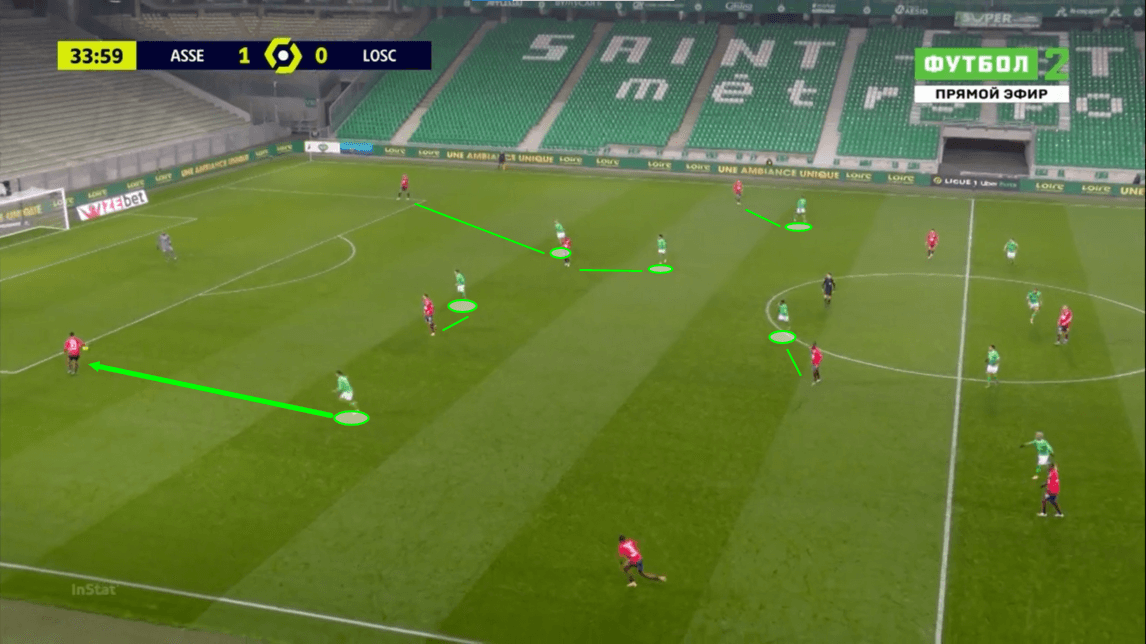
Puel’s wingers, on the other hand, enjoyed even more freedom to press the Lille backline aggressively and we can see an example of one occasion where Bouanga did just that in the image above.
Here, we can see the two Saint-Étienne strikers in position, sticking close to the nearest central midfielder to them, while other Saint-Étienne players inside of the opposition half also got near to potential near passing options and the home side’s back four stayed just inside of their half and quite horizontally compact.
However, we can see that Bouanga is not particularly tight to any Lille player here and that’s because he’s in the process of closing down Fonte as he receives the ball. Thanks to his pace and how he angled his run to block the passing lane to Lihadji, this press was effective at preventing Fonte from turning and he ends up forcing the Portuguese centre-back to play the ball back to Maignan who launches the ball upfield, indicating how effective this pressure was at preventing Lille from building out from the back comfortably.
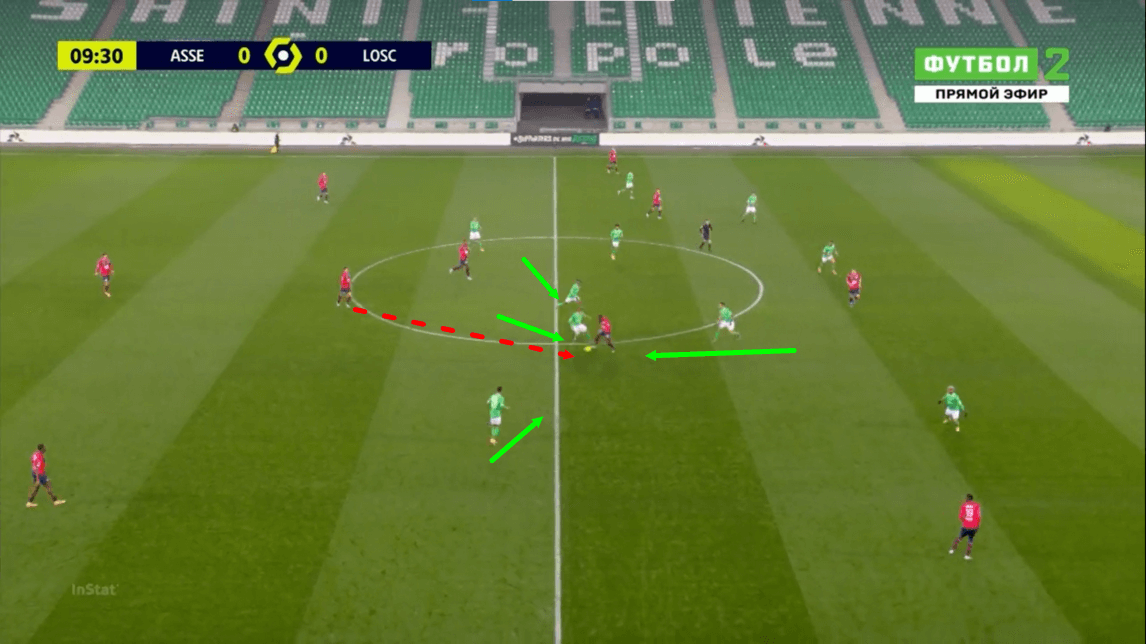
On occasions when Lille did manage to build into central midfield, for the majority of the game, Saint-Étienne were well able to deal with the issue quickly and effectively. The image above shows us how they managed to do this.
Just before this image was taken, Ikoné received the ball after dropping deep into central midfield, however, as the attacker picked up the ball, Saint-Étienne players quickly crowded around him and prevented him from turning or going very far at all.
One centre-back came out of the backline to close him down from behind, as did one striker from the opposite side. Meanwhile, the nearest winger and nearest central midfielder also closed in on him from opposite sides to create something of a closing box around the attacker which helped Saint-Étienne to quickly regain possession in central midfield. Saint-Étienne utilised this trap effectively throughout the game. The players were well-drilled to perform this action at pace whenever Lille built into central midfield and it worked well particularly in the first half and the early stages of the second half.
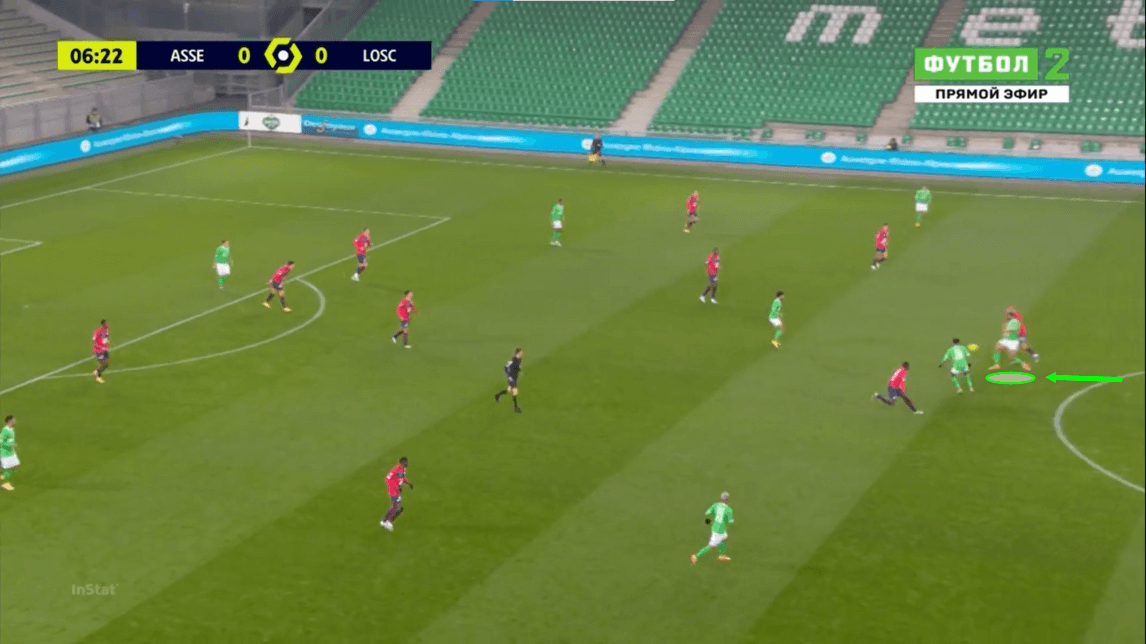
It was normal for Saint-Étienne’s centre-backs to act as we saw Kolodziejczak act in the previous passage of play when he left the backline to press high and join his teammates in trying to win the ball back higher up the pitch. Puel likes his centre-backs to play aggressively and fill gaps between the backline and the midfield line when the opposition manages to play the ball into them and we saw plenty of that in this game, as the image above shows.
Just before this image was taken, Lille won the ball back deep in their half and immediately tried to find Yılmaz, however, the ball to the Turkish forward was intercepted by Moukoudi who burst out of the backline to shut down this Lille counter-attack and win the ball back inside of the opposition half for his side.
We saw Saint-Étienne’s centre-backs act like this on a few occasions in this game, which won’t have come as a surprise to many fans of Les Verts or Puel, as this is a common theme to Auvergne-Rhône-Alpes club’s game.
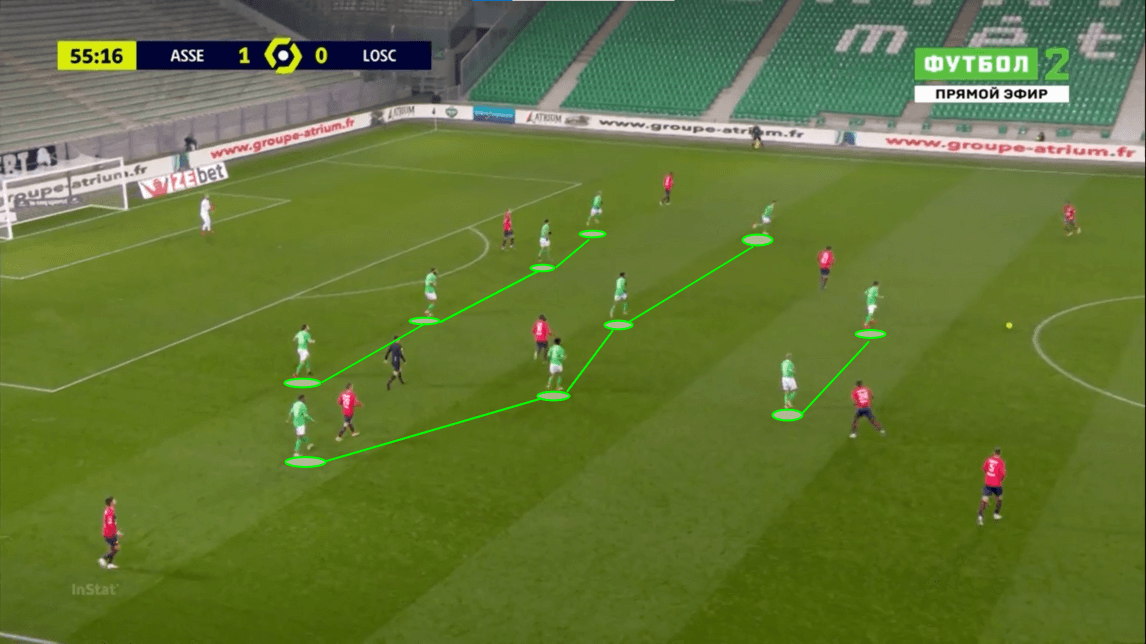
The last aspect of Saint-Étienne’s tactics without the ball that we’re going to provide some analysis of here is how they defended in deeper areas of the pitch and we can see an example of their 4-4-2 shape while defending much deeper inside of their half than we’ve seen them previously in the image above.
While they are defending deeper than before here, with Lille in possession of the ball inside of the home side’s half, they remained very vertically compact and kept a relatively high line, so while they did give up some space in behind the defensive line, they limited the amount of space that their opponents had to play in just in front of the penalty area.
The home side aimed to limit the space in central areas high up the pitch just in front of the box and they did so effectively, though Lille did still manage to exploit central space at times and they also enjoyed plenty of space out wide from where they could force Saint-Étienne’s shape back into their box or cause plenty of problems on the ball.
Lille’s tactics without the ball
As for the away side, Lille’s defensive tactics differed significantly in the second half compared to the first half. This change in tactics played an important role in the change in Lille’s fortunes for the second 45 minutes. Firstly, we’ll look at how the away side defended in the first half.
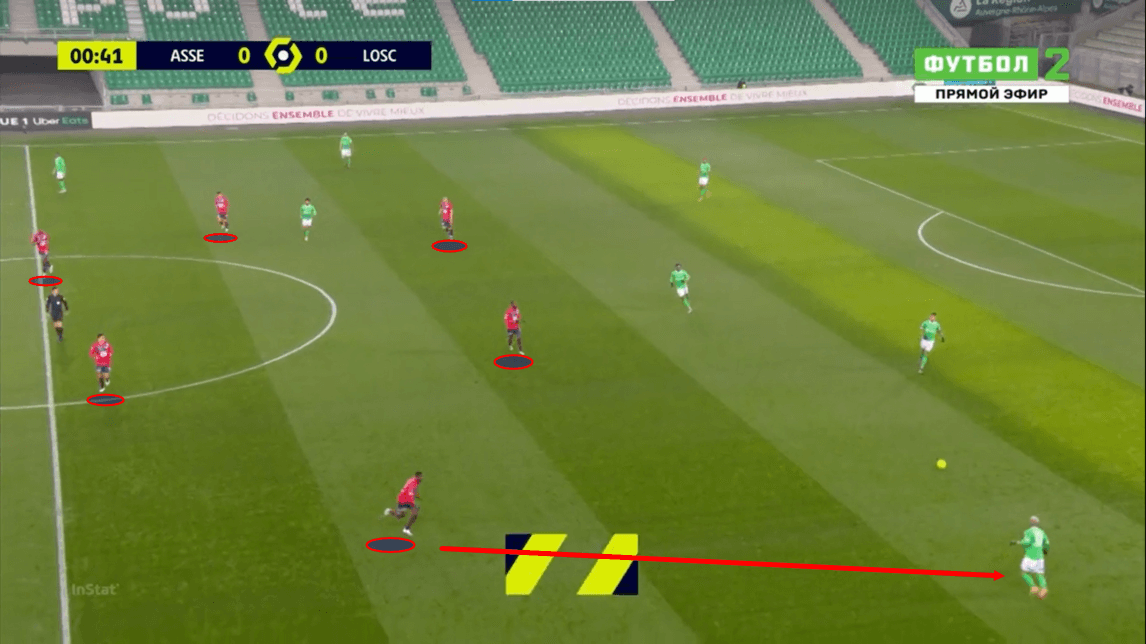
The image above shows us an example of Lille’s typical defensive shape from the first half, we can see them lined up in their 4-4-2 mid-block, with the midfield and forward lines combining to form a hexagon around the central midfield area just in front of Saint-Étienne’s backline.
This was effective in cutting off this particular bit of space, but Saint-Étienne deployed several creative tactics on the ball to get around the defensive tactics of Lille which nullified the home side’s tactics off the ball to an extent.
Lille’s front two of Ikoné and Yılmaz rarely put pressure on Saint-Étienne’s backline during the build-up, instead, sitting a bit deeper and preparing to cut off potential Lille passes into central midfield, as a result, Saint-Étienne’s central defenders tended to enjoy plenty of time and space on the ball to pass it about and try to help Les Dogues to build past Saint-Étienne’s front and midfield lines.
However, as the image above shows us, Lille’s wingers did press the backline more aggressively when the ball was played out to the Saint-Étienne full-back. These players tried to pressure the wide defenders and prevent them from building the play upfield and they enjoyed moderate success, often forcing them to play the ball back to the central defender but this plan wasn’t flawless and Saint-Étienne did manage to beat the press a few times.
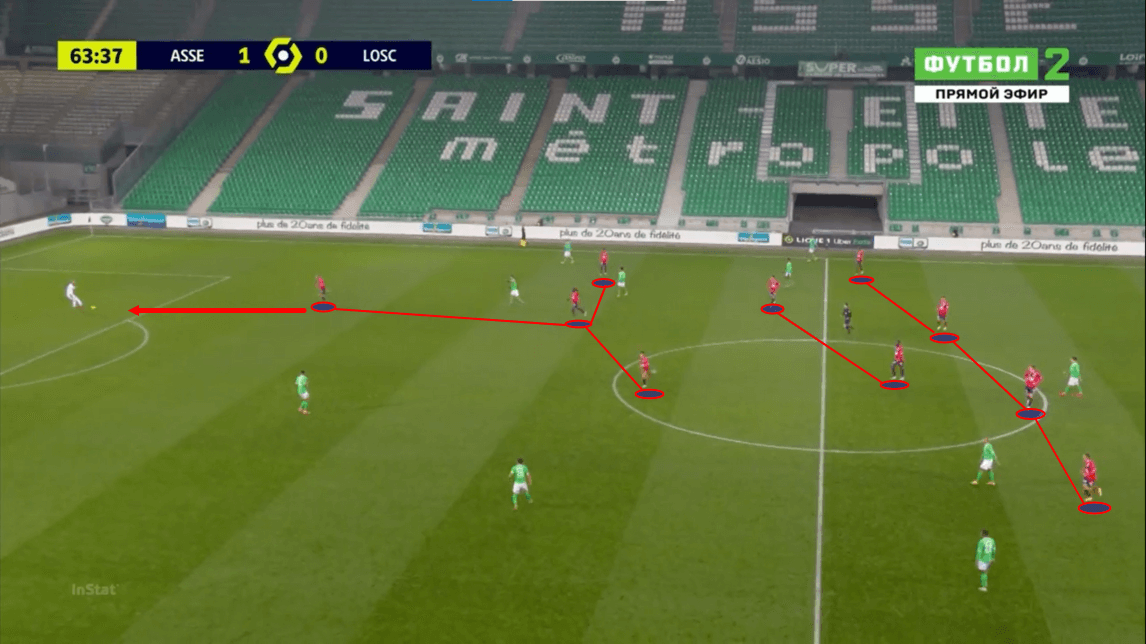
In the second half, as a result of their initial defensive tactics not resulting in great success, Lille pressed far more aggressively and they also altered their shape, switching to a 4-2-3-1 which we can see in the image above. This saw Yılmaz begin to press from the very front rather than sit in his slightly deeper central position alongside Ikoné. We can see Yılmaz pressing as far as the opposition goalkeeper in this particular image, for example.
The line of three behind Yılmaz also pressed quite aggressively from the front, now applying pressure to Saint-Étienne’s backline along with Yılmaz and this change in defensive tactics from Les Dogues certainly paid off, as the additional levels of pressure on Saint-Étienne’s backline resulted in the home side’s defenders making more errors in the second half which then gave Lille more counter-attacking opportunities from dangerous areas and Galtier’s men were dangerous in transition, so they did well to force more errors and create more counter-attacks in the second half.
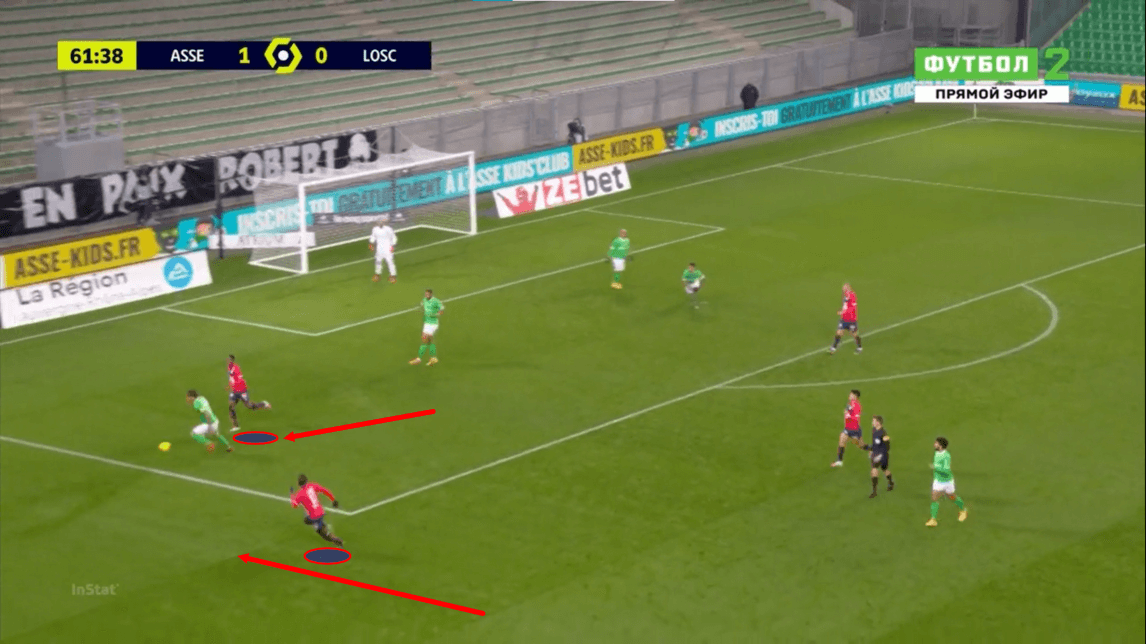
This next image shows us one of the ways in which Lille’s front four pressed Saint-Étienne’s backline. Here, we can see Yılmaz occupying the centre forward position. While he was more active off the ball in the second half, he only really applied pressure centrally and didn’t press out into wide areas much. Instead, he remained central and the nearest winger to the ball, as well as the number ‘10’, would press the Saint-Étienne defender on the ball out wide aggressively, attempting to double up on him as we can see in this image.
In the first half of the game, Saint-Étienne were quite comfortable on the ball in their half, they weren’t pressed very aggressively in deep areas and they were able to play their way out from the back with relative ease, while moving Lille’s defensive shape about, creating gaps and breaking through.
In the second half, Lille were much more aggressive about actually trying to win the ball back instead of just trying to prevent Saint-Étienne from building into the midfield and this resulted in Lille forcing far more turnovers and, again, creating more of those dangerous counter-attacking situations in which Lille thrived.
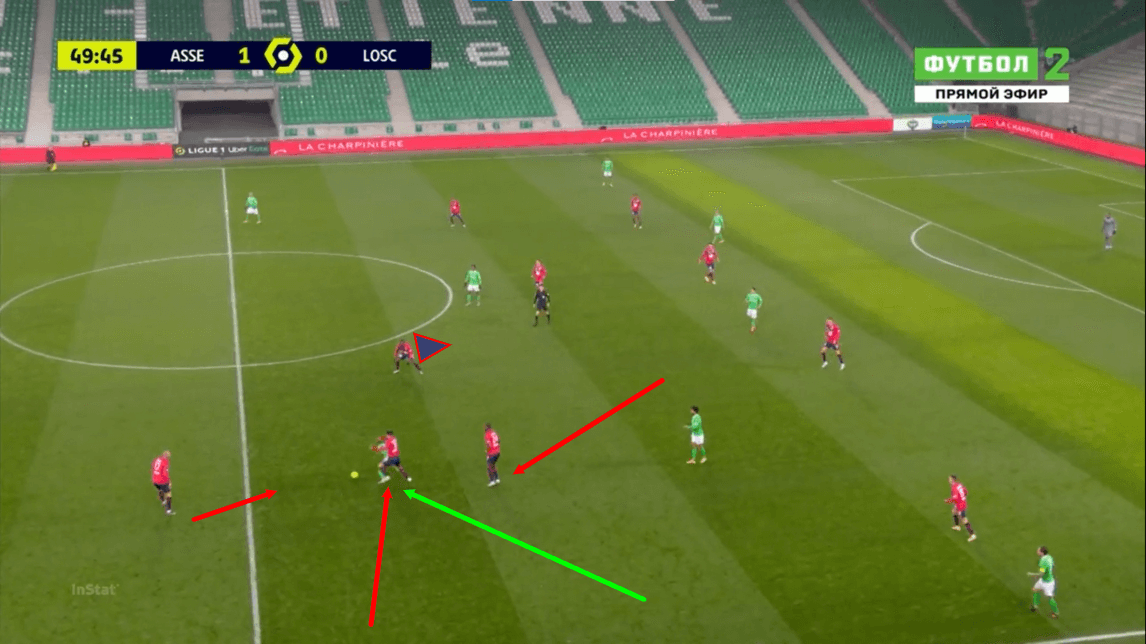
This next image shows us another example of how Lille pressed in the second half of this game but here, we can see a Saint-Étienne player in possession of the ball further up the pitch just inside of Lille’s half.
Lille took advantage of Saint-Étienne’s players’ tendency to try and dribble their way out of trouble and, at times, hold onto the ball for too long, to a great extent in the second half of this game. The away side forced turnovers in dangerous areas by taking advantage of this aspect of Saint-Étienne’s game in the second half and we can see one such example of this in the image above.
Here, the Saint-Étienne player has held onto the ball for too long and has found himself surrounded by Lille shirts. This, again, provides us with an example of how Lille’s defensive tactics changed in the second half, as their defensive shape here is much different than we saw from the first half example earlier.
As this Saint-Étienne player dribbled into this position, Soumaré advanced from deep, while Yılmaz and Araújo also closed in on him, while the number ‘10’ Ikoné stayed on the opposite side of the player to Araújo, preventing the possibility of the player making a pass into or dribbling out of danger via the centre of the park and as this particular passage of play moves on, Lille regain possession just on the halfway line and immediately counter.
Saint-Étienne’s tactics with the ball
As we mentioned previously, Saint-Étienne utilised various interesting tactics in possession of the ball, particularly during the build-up during the first half, to play past Lille’s defensive shape and create chances. We’ll look at some of those interesting tactics in this section of analysis and explain how they helped Les Verts to open the scoring in this game.
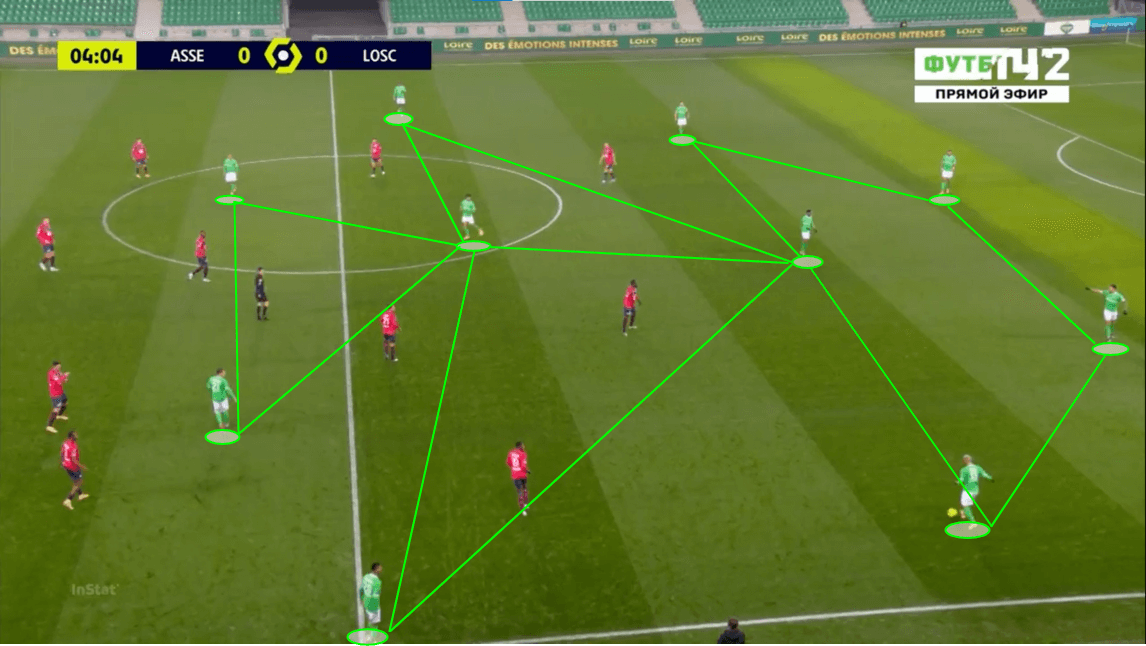
Firstly, this image above shows us how Saint-Étienne lined up in possession of the ball for Sunday evening’s game. They essentially created a 4-2-4 shape with the wingers pushing up high to form a frontline alongside the two centre forwards and their two central midfielders staggered so that one was positioned just behind the front four and one was positioned just in front of the two centre-backs.
Neyou frequently performed the role of the midfielder who dropped in front of the centre-backs during this game and he was effective in this role. In the first half, as he dropped into deeper areas, he usually escaped the Lille strikers’ pressing and used his ball-playing ability to progress the ball upfield and help his side to build into the opposition’s half of the pitch.
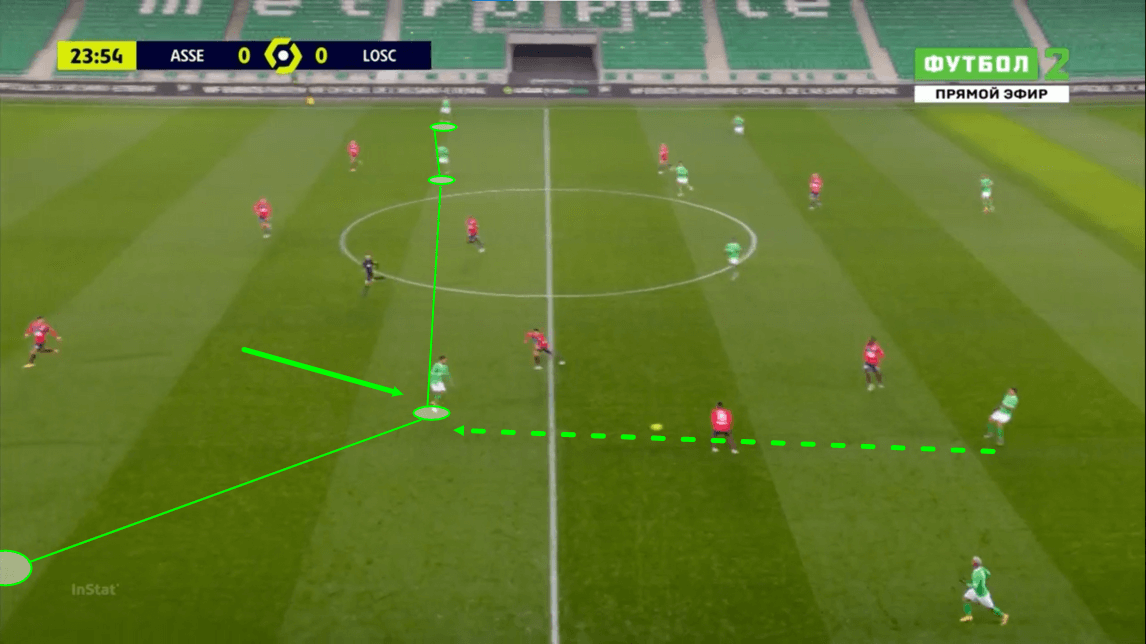
This next image shows us one way in which Saint-Étienne’s centre forwards helped their side to progress play from the back, through the midfield and into the opposition’s half of the pitch. Saint-Étienne’s two strikers, Hamouma and Khazri, both dropped in between the lines to provide short-passing options for deeper-positioned players at times during this game.
We can see Hamouma doing this in the image above and as he drops in between the lines to give Kolodziejczak a short-passing option just beyond the centre of midfield, the centre-back finds him and this pass allows the home side to break through Lille’s first two lines of pressure and continue to attack inside of Lille’s half of the pitch.
On some occasions when the Saint-Étienne strikers moved like this, they dragged Lille’s centre-backs out of position as they followed their movement deep and this created a gap inside of the backline for other Saint-Étienne players to potentially exploit so it’s clear from the example above, and that explanation of other ways in which this movement proved effective, that this was a key element of Saint-Étienne’s tactics on the ball for Sunday’s game and it helped Les Verts to put Lille’s backline under pressure.
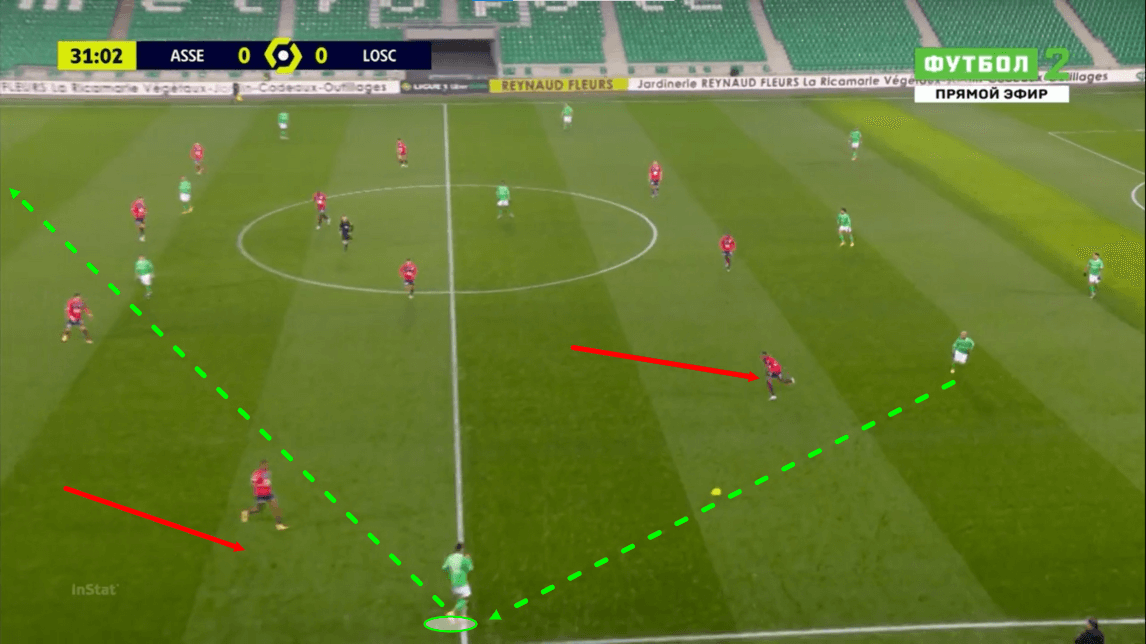
Another way in which Saint-Étienne beat Lille’s first two defensive lines and built into Les Dogues’ half of the pitch from the back was by playing the ball from their backline out to the winger, as we can see in this image above.
As we previously mentioned, while Lille’s strikers didn’t usually press Saint-Étienne’s centre-backs very aggressively, the wingers did press Saint-Étienne’s full-backs but Puel’s men used that to their advantage and manipulated Lille’s defensive shape as a result.
Just before this image was taken, left-back Trauco received the ball in quite a central position and as Lihadji pressed him, this created space out wide for left-winger Bouanga to drop into and exploit and as he receives the ball, he enjoys plenty of time before Lille right-back Djaló can get to him and on this occasion, the playmaker sends the ball upfield curling towards goal and this results in Saint-Étienne winning a penalty which they converted to score their only goal of the game.
Saint-Étienne liked to utilise their wide men like this during the build-up to exploit Lille’s lack of width in the centre of the park and as we can see, it proved to be a very effective tactic.
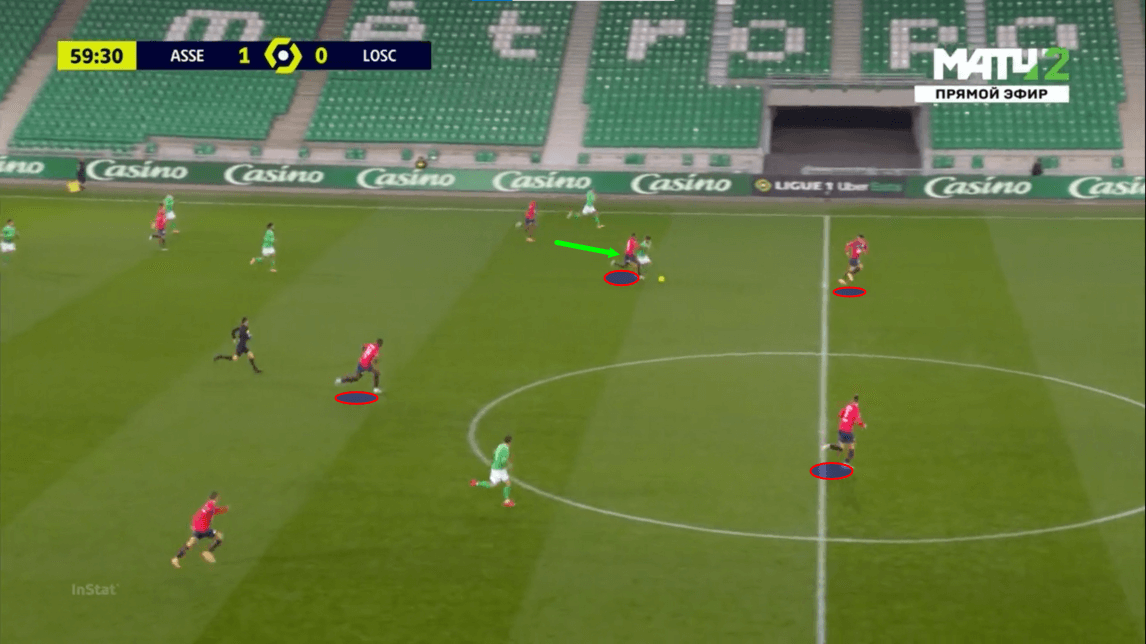
Lastly, one negative to Saint-Étienne’s tactics on the ball was how ineffective their counter-attack attempts proved to be in the second half of the contest. They were unable to threaten Lille on the counter for the vast majority of the second half because of how direct they played.
Immediately after winning the ball back, Saint-Étienne’s front four constantly ran straight at Lille’s backline, they never slowed the game down and allowed other teammates to catch up, they always carried the ball forward after regaining possession and at times it resulted in those players essentially waiting their energy and running straight into a dead end, as multiple Lille players surrounded them and managed to dispossess them.
This was partly a result of Lille’s offensive tactics, which we will come onto, and how they pinned Saint-Étienne back into their half resulting in very few men being ahead of the attackers and so, when they won the ball back and countered, they failed to threaten Lille because of how many extra men Les Dogues had and Saint-Étienne’s attackers didn’t come at the away side with a great deal of pace so that, combined with the fact Lille had the overload, resulted in Saint-Étienne squandering plenty of counter-attacking opportunities as they continued to play very direct when perhaps, at times, they should have slowed the game down.
Lille’s tactics with the ball
Last but not least, we’ll take a look at Lille’s tactics with the ball from Sunday’s Ligue 1 draw with Saint-Étienne. In this section of the analysis, we’ll examine Les Dogues’ general offensive shape, as well as a key aspect to their offensive game from the first half as well as a key aspect to their offensive game from the second half.
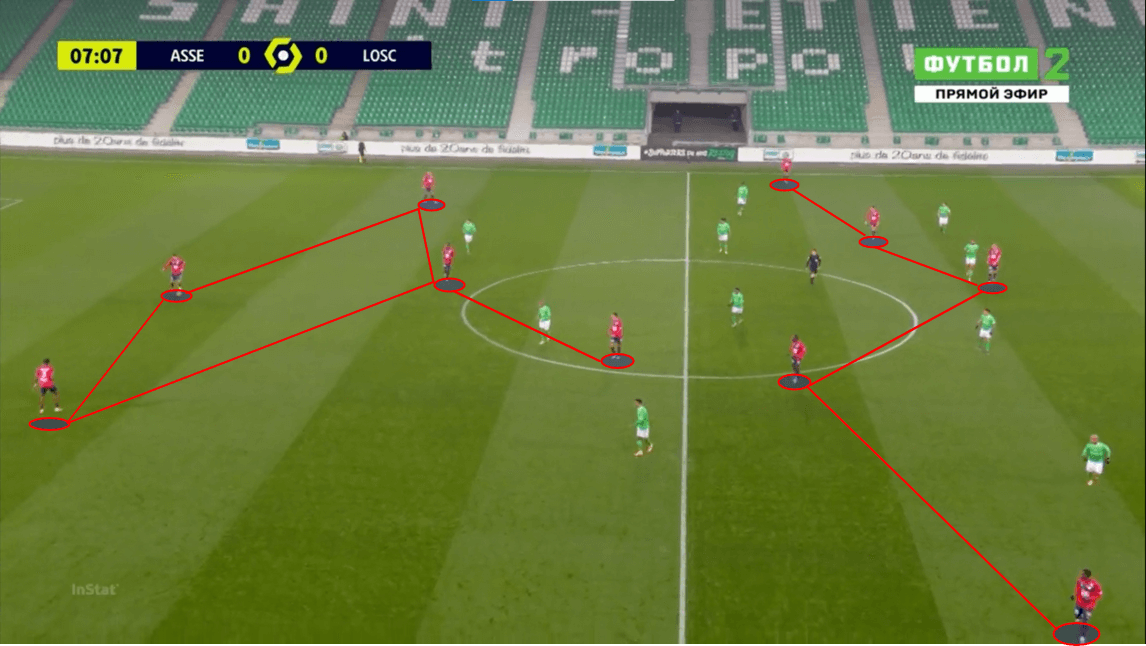
This image above shows us Lille’s offensive shape during the build-up from Sunday’s game. Here, we can see the back three that Galtier’s side formed during the build-up with Djaló becoming the right centre-back alongside Fonte in the centre of the back three and Botman at the left side of central defence.
Soumaré and André placed themselves just in front of that front three and staggered their positioning, similarly to how Saint-Étienne’s midfielders acted in this scenario, while Lille’s front line of five consisted of Bradarić and Lihadji providing the width, Ikoné and Araújo occupying the half-spaces and Yılmaz playing at the centre of the attack.
Despite altering their tactics in some ways to improve their build-up play, Lille retained this general offensive structure for the full 90 minutes, indicating that perhaps it is a valuable element to their game despite their first-half struggles to play past Saint-Étienne’s press.
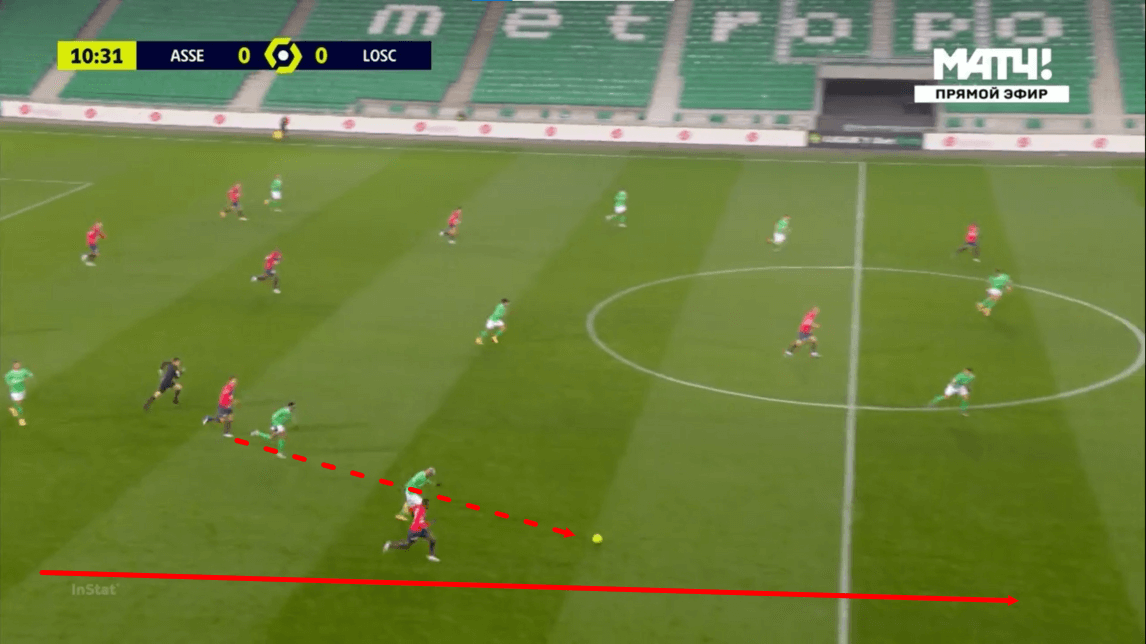
In the first half though, Lihadji played a particularly prominent role for the away side. His pace and dribbling quality were on display on the right-wing and the teenager was particularly useful for his side on the counter-attack, as we can see in the image above.
Just before this image was taken, Lille won the ball back deep inside of their half and as they did so, André began carrying the ball upfield until Lihadji managed to create enough space where he became a viable passing option on the right-wing running in behind the Saint-Étienne defensive line, as he got in behind Saint-Étienne’s defensive line, Lihadji could then receive this pass and run at Saint-Étienne’s last line of defence, with the pacey wide man demonstrating very little drop off in his speed upon taking control of the ball.
Lihadji was also targeted by both Botman and Soumaré for cross-field long-balls from the left side of the pitch, as Saint-Étienne’s left-back tended to sit quite narrow off the ball and this allowed Lihadji to potentially enjoy an additional bit of space out wide on the right-wing, while this also helped Lille to get the winger 1v1 versus the opposition’s full-back, however, he was ultimately unable to provide a goal contribution in this one despite threatening on occasion.
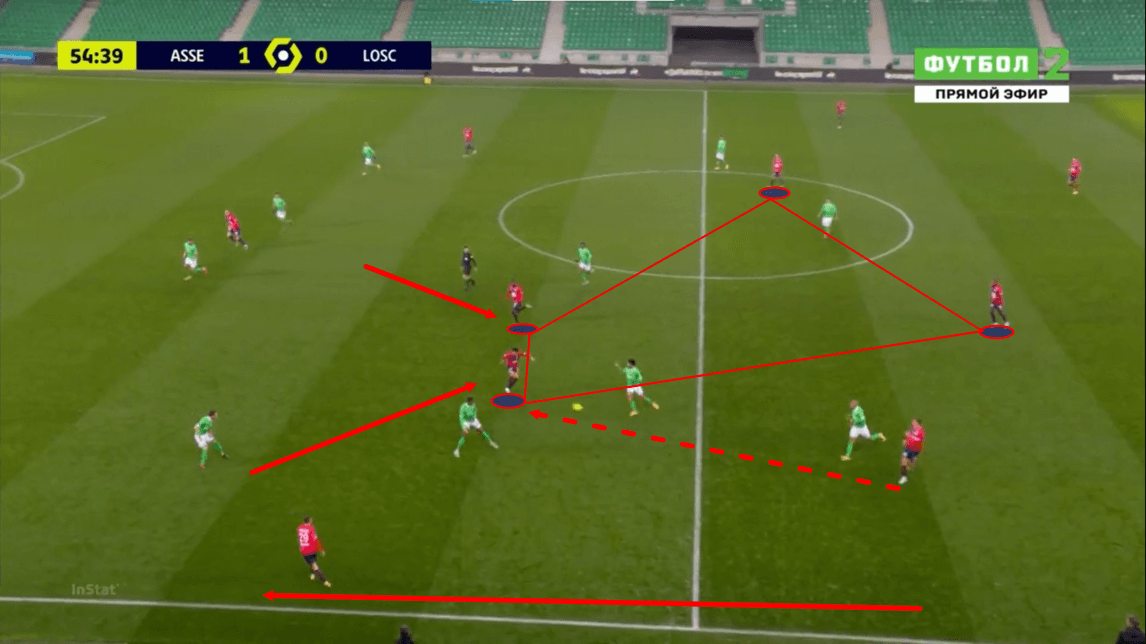
Next up, we’ll look at how Lille solved their problem of getting crowded out in the centre of the pitch in the second half of Sunday’s game. Their switch to the 4-2-3-1 also resulted in a change in tactics concerning the positioning of their wingers and the number ‘10’.
In this image above, we can see Araújo preparing to receive the ball in the left half-space and that’s because the winger shifted inside to position himself alongside number ‘10’ Ikoné.
Similarly to Saint-Étienne and their strikers, these two players’ movement and positioning provided Botman with a progressive passing option in between the lines and the fact that these players positioned themselves next to one another while Lille’s central midfielders were also nearby in slightly deeper positions prevented Saint-Étienne from simply crowding around the ball-receiver and dispossessing them quickly as they’d done previously on numerous occasions, and allowed Lille to fill the centre of midfield with four/five players of their own to avoid getting overloaded by Saint-Étienne men again.
This was very effective in helping Lille to build into the opposition’s half in the second half of the game and this increase in the ease of their build-up, combined with the increased intensity of their pressing led to them enjoying much more of the ball and creating many more chances while limiting Saint-Étienne’s in the process.
Conclusion
To conclude this tactical analysis piece, it’s clear that Saint-Étienne’s pressing and the ease with which they played through Lille’s defensive shape in the first half led to them taking the well-deserved lead in this game.
However, Lille’s second-half tactical alterations changed the course of this game and shifted momentum back in favour of Les Dogues, as their pressing and development of central superiority led to them creating far more chances in the second half.
Overall, this was a game of two halves and so, perhaps a 1-1 draw is fair enough.




Comments